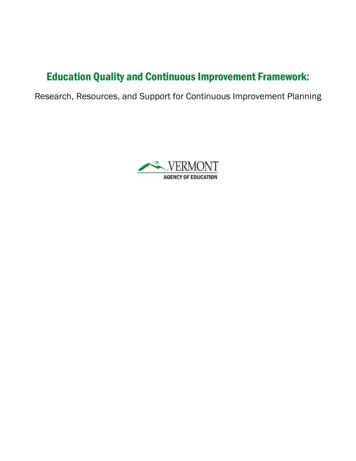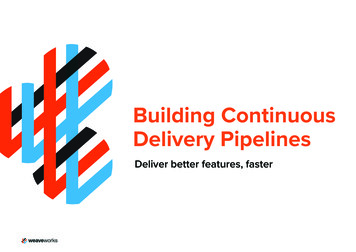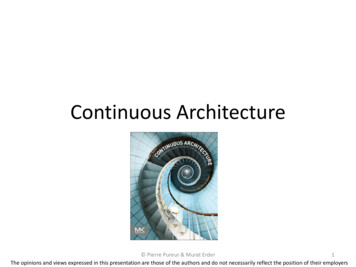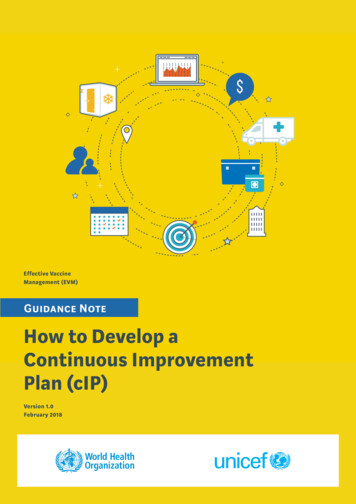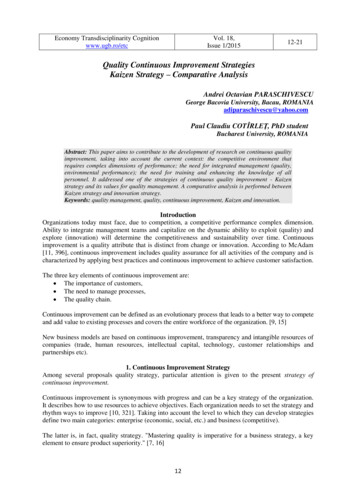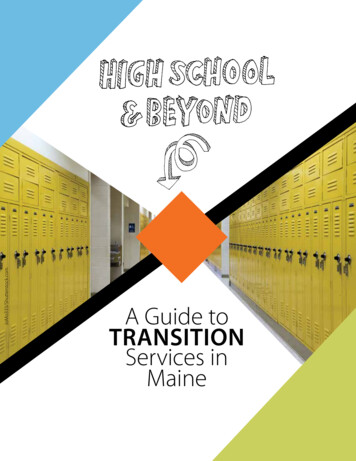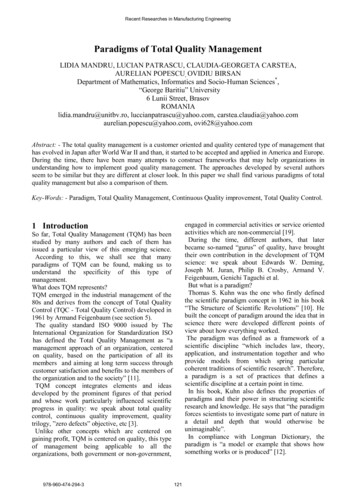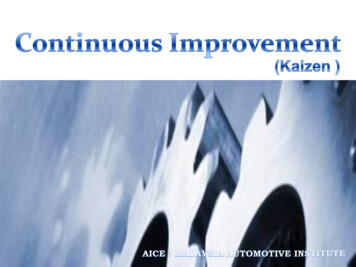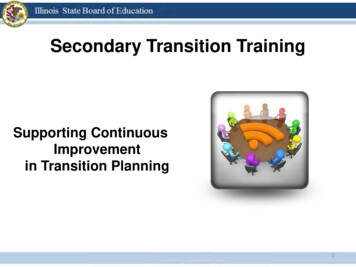
Transcription
Secondary Transition TrainingSupporting ContinuousImprovementin Transition Planning1
State Performance Plan: Indicator 13Introduction The legal framework Indicator 13 measurementdetails Information aboutfindings ofnoncompliance Indicator 13 DataVerification Audit Data Verification Rubric2
Post-Secondary Success is Embedded inIDEAThe purpose of IDEA is to ensure that all children withdisabilities have available to them a free, appropriate publiceducation (FAPE) that includes special education andrelated services designed to meet their unique needs andprepare them for further education, employment andindependent living.(34CFR§300.1(a))3
Federal Transition RequirementsBeginning not later than the first IEP to be in effect when thechild turns 16 . . . and updated annually, thereafter, the IEPmust include –– Appropriate measurable post-secondary goals basedupon age appropriate transition assessments relatedto training, education, employment, and, whereappropriate, independent living.(34CFR §300.320(b)(1))– The transition services (including course of study)needed to assist the child in reaching those goals.(34CFR §300.320(b)(2))4
Illinois Transition Requirements Transition planning begins for the first IEP that will be ineffect at the age of 14 ½ years. Transition planning for Independent Living is arequirement. (PA 098-0517) Students can delegate their educational decision-makingrights to their parent/guardian or other adult.(105 ILCS 5/14-6.10)5
Definition of Transition n.pdfa)Transition services means a coordinated set ofactivities for a child with a disability that:1. is designed within a results-oriented process, that isfocused on improving the academic and functionalachievement of the child with a disability to facilitatemovement from school to post school activities,including post-secondary education, vocationaleducation, integrated employment, continuing andadult education, adult services, independent living orcommunity participation 2. is based on the individual child’s needs, taking intoaccount the child’s strengths, preferences andinterests;34CFR §300.43(a)6
Federal Definition: SPP Indicator 13States must report their level of compliance for SPP Indicator 13 inthe Annual Performance Report. States submit Indicator 13 databased on all students who are age 16 and above and have an IEP.“Percent of youth with IEPs aged 16 and above with an IEPthat includes appropriate measurable post-secondary goalsthat are annually updated and based upon an age appropriatetransition assessment, transition services, including coursesof study, that will reasonably enable the student to meet thosepost-secondary goals, and annual IEP goals related to thestudent’s transition services needs. There also must beevidence that the student was invited to the IEP Team meetingwhere transition services are to be discussed and evidencethat, if appropriate, a representative of any participatingagency was invited to the IEP Team meeting with the priorconsent of the parent or student who has reached the age ofmajority.” 20 U.S.C. 1416(a)(3)(B)7
Findings of NoncomplianceDistricts who don’t meet the measurable and rigoroustarget of 100% for Indicator 13.Indicator 13 Data Verification Audit is an activity that isused to verify compliance.All findings of noncompliance must be corrected within12 months of issuance.8
Data Verification AuditThe SPP Indicator 13 Data Verification Audit will continue in LEAs across the state. 34CFR §300.640 outlines the SEA’s responsibility to submit data required by section 618 ofthe IDEA. The State Performance Plan details the required improvement activities foreach indicator.Districts are randomly chosen and sent a letter outlining the process, timeline,requirements, and a sample of up to 15 students, ages 16 and above.Districts submit documentation for the list of students.ISBE uses the Data Verification Audit Rubric to score the sample students.Districts will be sent a letter and a copy of the scored rubrics.Districts who “do not meet” will be sent a letter with instructions for corrective action.The Indicator 13 Data Verification Rubric and other valuable tools and resources fortransition planning are located on ISBE’s ndicator13.htm9
Indicator 13 Rubric10
State Performance Plan: Indicator 13Segment 1Rubric Item 1: Measurable PostSchool Goals11
Indicator 13: Rubric Item 112
Indicator 13: Rubric Item 1A measurable post-secondary goal must bedeveloped and written in the following areas fortransition-aged students aged 14 ½ and above inIllinois: Education and/or training Education: community college, university, technical/trade/vocational school Training: vocational or career field training, independent living skill training,apprenticeship, on the job training, job corp Employment Paid employment (competitive, supported) Non-paid employment (volunteer, in a training capacity) Military Independent Living Independent living skills, health/safety, financial/income, transportation/mobility, social relationships, recreation/leisure, self-advocacy/future planning13
Selected Resources to Assist in DevelopingTransition Independent Living GoalsCasey Life Skills http://lifeskills.casey.orgCasey Life Skills is a free practice tool and framework to assess independentliving skills. This assessment measures in the following domains: Daily Living SkillsSelf Care SkillsRelationships & Communication SkillsHousing & Money ManagementWork & Study SkillsCareer & Education PlanningIllinois’ Social and Emotional Learning Standardshttp://isbe.net/ils/social emotional/standards.htm14
Concern Over Post-Secondary Goals“If it is stated as a measurable goal that occursafter students have left the LEA. I’m concernedabout liability issues when students don’t meetthose stated goals after school.”IDEA does not require that local educationagencies (LEAs) be held accountable for students’attainment of post-secondary goals. The postsecondary goals are required components oftransition planning.15
Transition Responsibility of SchoolsSchools ARE responsible for: providing the educational programs andtransition services stated in the IEP.Schools ARE NOT responsible: if the post-secondary goal is not attainedby the young adult.16
Measurable Post-Secondary GoalA measurable post-secondary goal uses results orientedterms such as:“enrolled in”“work”“part time”“full time”Formula provided by the National Secondary TransitionTechnical Assistance Center:WILL .(After High School)(student)(behavior)where & how)17
State Performance Plan: Indicator 13Segment 2Rubric Item 2: Post-secondaryGoals UpdatedAnnually18
Indicator 13: Rubric Item 219
Updating Post-Secondary Goals AnnuallyThree post-secondary goals were included in the IEP. The IEP was updatedwithin 12 months as indicated by the following examples:Example: “date of last review” and “signature dates on the currentIEP”.The goals meet I-13 standards for Item #2 for the following reasons:a) post-secondary goals were identified in conjunction withdeveloping the IEP and the IEP was reviewed with 12months of the previous IEP.Example: Present Level of Academic and Functional Performance(PLAAFP) indicates that “since last school year”The goals meet I-13 standards for Item #2 for the following reasons:a) “since last year” indicates that the information wasupdated annually and contributed to the post-secondarygoals identified in this IEP.20
State Performance Plan: Indicator 13Segment 3Rubric Item 3: Post-secondaryGoals Based onAge-AppropriateTransitionAssessments21
Indicator 13: Rubric Item 322
Transition AssessmentsMust Address These 23
Indicator 13: Rubric Item 3Guidance from the National Technical Assistance Center on Transitionlocated at http://www.transitionta.org. (This has replaced NSTTAC).Become familiar with different types of transition assessments and theircharacteristics.Select methods that assist students by helping them answer: Who am I?What do I want in life, now and in the future?What are some of life’s demands that I can meet now?What are the main barriers to getting what I want from school andcommunity? What are my options in the school and community for preparing me forwhat I want, now and in the future?24
Indicator 13: Rubric Item 3Formal transition assessments:––––––Adaptive behavior/daily living skills assessmentsGeneral and specific aptitude testsInterest inventoriesIntelligence testsTemperament inventories/instrumentsCareer maturity or employability testsInformal transition assessments:–––––Interviews (student and family)QuestionnairesDirect observationCurriculum-based assessmentsEnvironmental analysis25
Examples of Age-AppropriateTransition Assessments Social HistoriesCareer CruisingExplore TestPLAN testPSAEAssessment of TechnologyNeedsInterest InventoriesCareer Interest InventoryLearning Styles InventoryIndependent Living SkillsQuestionnaireSocial Skills InventoriesKuder Assessment ACT/SATASVABThink LinkTransition Planning InventoryStudent Interview InventoryVocational EvaluationCompass TestWork KeysFamily InterviewsCareer PortfoliosPerson-Centered PlanningEmployability Skills InventoryMechanical Aptitude TestPersonality Scales26
Examples of Non-Appropriate TransitionAssessments STEP program Student Career Plan Resource Management Class Career Day Transition Fair Career Counseling DRS Coordination Transition Planning Coursework27
State Performance Plan: Indicator 13Segment 4Rubric Item 4: Transition Services28
Indicator 13: Rubric Item 429
Transition Services Instruction is one component of a transition program that “the student needsto receive in specific areas to complete needed courses, succeed in thegeneral curriculum, and gain needed skills.” Storms, J., O’Leary, E., & Williams, J. (2000).Transition requirements: A guide for states, districts, schools, universities and families. Eugene: University ofOregon, Western Regional Resource Center. Related service is defined as “transportation, and such developmental,corrective, and other supportive services (including speech-languagepathology and audiology services, interpreting services, psychologicalservices, physical and occupational therapy, recreation, including therapeuticrecreation, social work services counseling services, includingrehabilitation counseling, orientation and mobility services, and medicalservices, except that such medical services shall be for diagnostic andevaluation purposes only) as may be required to assist a child with adisability to benefit from special education .” Individuals with Disabilities EducationImprovement Act of 2004, Public Law No. 108-446, 20 U. S. C. 1400, H. R. 1350. Community experiences are one component of a transition program “that areprovided outside the school building or in community settings. ” Storms, J.,O’Leary, E., & Williams, J. (2000). Transition requirements: A guide for states, districts, schools, universitiesand families. Eugene: University of Oregon, Western Regional Resource Center.–30
Transition Services (cont.) Employment and other post-secondary adult living objectives are components oftransition that “the student needs to achieve desired post-secondary goals.These could be services leading to a job or career or those that support activitiesdone occasionally such as registering to vote, filing taxes, renting a home,accessing medical services, filing for insurance or accessing and planning foradult services such as Social Security Income (SSI).” Storms, J., O’Leary, E., & Williams,J. (2000). Transition requirements: A guide for states, districts, schools, universities and families. Eugene:University of Oregon, Western Regional Resource Center. Acquisition of daily living skills is a component of transition that is included “ifappropriate” to support student ability to do those activities that “adults doevery day.” Storms, J., O’Leary, E., & Williams, J. (2000). Transition requirements: A guide for states,districts, schools, universities and families. Eugene: University of Oregon, Western Regional ResourceCenter. Functional vocational evaluation is a component of transition that is included “ifappropriate.” This evaluation involves “an assessment process that providesinformation about job or career interests, aptitudes, and skills. Information maybe gathered through situational assessment, observations or formal measures,and should be practical. The IEP team could use this information to refineservices outlined in the IEP.” Storms, J., O’Leary, E., & Williams, J. (2000). Transitionrequirements: A guide for states, districts, schools, universities and families. Eugene: University of Oregon,Western Regional Resource Center.31
Transition Services - ExamplesPost-Secondary Goal:Upon completion of high school, John will attend LincolnLand Community College.Transition Services:Instruction: John will receive tutoring in reading comprehensionstrategies.Related Services: John will receive counseling services to increaseability to manage anger.Community Experience: John will have three visits to Lincoln Land’sDisability Services Office.Development of Employment: John will take Lincoln Land’s entranceprep exam.Daily Living Skills: John will use resources such as publictransportation to attend classes at Lincoln Land.32
Transition Services - ExamplesPost-Secondary Goal:After graduation, Kevin will participate in habilitative andfunctional skill training through the ARC of Chicago andwill attend courses designed to provide specializedacademic, functional, and occupational preparation.Transition Services:Daily Living Skills: Maintain a bank account, practice safety skills in thecommunity, select clothing for the day, express preferences relatedto saving money for personal use.Employment and Other PS Living Objectives: Meet with job coach inclassroom and community settings, meet with SSI representative todetermine possible financial benefits, vocational rehabilitationreferral.Functional Vocation Evaluation: Refer to DRS for non-verbal, modifiedassessments of adaptive behavior, career interests and skills.33
State Performance Plan: Indicator 13Segment 5Rubric Item 5: Course of Study34
Indicator 13: Rubric Item 535
Indicator 13: Rubric Item 5As you plan the course of study, consider these points: Does the transition plan include documentation thataligns with the student’s post-secondary goals? Does a post-secondary goal require or benefit from thesuccessful completion of specific high school coursessuch as A future chef planning to take and complete all cookingrelated classes; A future child care provider planning to take and completeall relevant Family and Consumer Science classes; A future auto body mechanic planning to take andcomplete relevant classes in ‘shop.”36
Indicator 13: Rubric Item 5 The Course of Study must be completed for all transition-agedstudents from the current year through the anticipated year ofgraduation. Writing the word elective does not provide theneeded documentation of a course of study that aligns with thestudent’s post-secondary goals. If a vocational class related to the student’s career interests isnot available due to budget constraints or other extenuatingcircumstances, state that either in the Course of Study orPLAAFP so that everyone involved knows that the student’sstrengths, preferences and interests were discussed. Delineate in the Course of Study to show the progression ofclasses that assist the student in meeting his/her transitionpost-secondary goals, i.e., Foods I, Foods II, etc.37
State Performance Plan: Indicator 13Segment 6Rubric Item 6: Annual Goals38
Indicator 13: Rubric Item 639
Indicator 13: Rubric Item 6For each post-secondary goal, is there at least one annual goal and short-termobjective included in the IEP related to the student’s transition services needs?Transition services are developed to assist the student in progressing toward theirpost-school goals. Therefore, annual goals are related to the post-secondary goals viatransition services.Annual goals are “statements that describe what a child with a disability canreasonably be expected to accomplish within a 12-month period in the child’s specialeducation program.” There must be at least one annual that ties back to each of the post-schoolgoals. An annual goal might be academic and transition, functional and transition,academic, functional and transition, or just transition.A Helpful Formula from NSTTACGivencondition(i.e., direct instruction,modeling, peertutoring)WILLstudentbehavior.criteria(i.e., 80%)time frame(i.e., by June, 2015)40
Post-Secondary GoalAfter graduation from high school, Jodi will participate in remedial educationcourses at the local community college focusing on life skills instruction,functional reading, functional math, productivity and basic employability skills.Present Level of Academic Achievement & FunctionalPerformance Jodi completed the Brigance Employability Skills Inventory which reported thatshe was functioning at grade 3 in reading and at grade 4 in math. Her intakeassessment suggested that she has adequate verbal skills. The quick-screenindicated she lacked basic employment literacy skills in math and reading.41
Annual GoalJodi will increase her inferential reading comprehension scores by one gradelevel as measured by classroom assessments by May 1, 2017, in order to improvethis skill in on the job training materials.ObjectivesGiven daily instruction and use of high-interest reading materials such as thenewspaper, young adult magazines, school-approved web-sites, and short storiesfor adults, Jodi will increase her reading comprehension by .5 grade level by theend of the first semester in the 2016–2017 school year.Given daily instruction and use of high-interest reading materials such as thenewspaper, young adult magazines, school-approved web-sites, and short storiesfor adults, Jodi will increase her reading comprehension by one grade level by theend of the 2016-2017 school year.42
State Performance Plan: Indicator 13Segment 7Rubric Item 7: Inviting Students43
Indicator 13: Rubric Item 744
Indicator 13: Rubric Item 7 For the current year, is there documentation in the IEP orcumulative folder that the student was invited to attend the IEPmeeting? Is the student’s invitation signed (by the LEA) and dated prior tothe date of the IEP meeting? Compliance is inclusion of the student’s name in the Notice ofConference letter as a person who is invited to the IEP meeting.45
State Performance Plan: Indicator 13Segment 8Rubric Item 8: Inviting OutsideAgencies46
Indicator 13: Rubric Item 847
Indicator 13: Rubric Item 8For the current year, is there evidence in the IEP that representatives ofany agencies/services were invited to participate in the IEP meeting,including but not limited to: post-secondary education, vocationaleducation, integrated employment (including supported employment),continuing and adult education, adult services, independent living orcommunity participation for this post-secondary goal?The 3-step process includes:Step 1: Are there transition services listed that are likely to be provided or paid for byan outside agency?Step 2: If there are such services, is there documentation that the parent/guardianand/or student who has reached the age of majority has provided consent to invite therelevant outside agencies?Step 3: If consent is obtained, is there evidence that one or more of the outsideagencies/services were invited to the IEP meeting to discuss transition?48
Indicator 13: Rubric Item 8Examples of Outside Agencies US Military representativeDHS DRS representativeLocal Social Security Administration representativeEmployerPost-Secondary education and training provider (e.g., office of disabilityservices)Independent Case Coordination Unit (PAS agency)Adult service agency representativesCenter for Independent Living (CIL)workNet Center representativeCommunity leaders such as religious leaders, recreation programs, andcounty extension agents**Individuals that are paid by and under the jurisdiction of the school districtare not considered outside agencies.49
Indicator 13: Rubric Item 8Once obtained, parent/student consent is valid for one year or less if a newmeeting is called prior to the annual review to discuss transition issues.Districts can choose a proactive plan to ensure that obtaining consent doesnot get in the way of outside agency participation. Examples include but arenot limited to:– After the current IEP meeting– At fall registration– At a well-attended parent night or other school functionFor those invited post-school service providers who declined and/or wereunable to attend the IEP meeting, is there evidence that alternative forms ofcommunication and information gathering were used to supportnetworking/access for the IEP team and specifically the family and/orstudent? (Note: Provide the agency information in the linkages section so thatthe student/family has it for future reference.)A sample consent form can be found tor13.htm50
Transition Rubric SummaryAge AppropriateTransition Assessments Interests, Needs, Preferences, StrengthsWrite MeasurablePost-Secondary Goals Education/Training, Employment, Independent LivingIdentify TransitionServicesCommunity Experience, Instruction, Related Services, Employment,Adult Living & Daily LivingWrite the Course ofStudyDelineate the course of studyWrite the Annual IEPGoalsIEP goal for each area of transitionCoordinate Serviceswith Adult AgenciesInvite Outside Agencies51
State Performance Plan: Indicator 13Segment 9Next Steps for Findings ofNoncompliance52
Next Steps for Findings of Noncompliance Correct identified noncompliance– Use the scored rubric as a guide Provide documentation of students who are nolonger under the jurisdiction of the district Assigned consultants (Indicator 13 Team) cancommunicate via e-mail, fax and/or phone If needed, on-site training may be provided todistricts who have a finding Findings of noncompliance must be closed withinone year of issuance ISBE is federally required to pull a second sample53
State Performance Plan: Indicator 13Segment 10 Transition Case StudiesResourcesConclusionIndicator 13 TeamMembers’ ContactInformation54
Transition Case StudiesUse the National Secondary Transition Technical Assistance Center (NSTTAC) case studies forother examples and non-examples of Indicator 13 requirements. The students in the casestudies represent a wide range of abilities to provide users with a wealth of examples.Students with: Specific learning disabilities: Refer to the case studies for Allison, Jason & John. Autism: Refer to the case study for Alex. Emotional behavioral disorder: Refer to the case study for Jamarreo. Intellectual disabilities: Refer to the case studies for Jeremy, Jodi, Lissette, Paulo &Stephanie. Severe, complex disabilities: Refer to the case studies for David, Kevin, Lily, &Rolanda.http://www.nsttac.org55
Additional InformationISBE has a continuum of tools available to assist districts in meeting SPPIndicator 13 requirements. The eight Indicator 13 statements/questions,based on the NSTTAC Indicator 13 Checklist vetted by OSEP, form the basisfor each of the following tools:SPP Indicator 13 Checklist: This checklist is a one page tool that can be usedas a vehicle to capture Indicator 13 data after the IEP meeting for entry toFACTS (Funding and Child Tracking System). The FACTS document is NOTthe same as the Indicator 13 rubric that is used in the evaluations oftransition plans. http://www.isbe.net/spec-ed/pdfs/indicator13 checklist.pdfIndicator 13 Data Verification Rubric: Districts and cooperatives can use therubric for staff training and self-assessment purposes. The rubric may beaccessed at coring-rubric.pdf56
Additional Information (cont)Indicator 13 Required Evidence of Correction: Districts and cooperatives can usethe Evidence of Correction form when given a finding by ISBE for noncompliancein one of the eight rubric areas. The form may be accessed dence-of-correction.pdf.Indicator 13 Summary Sheet: Districts and cooperatives may use this one pagesummary sheet that provides helpful tips on meeting compliance for Indicator 13.The summary sheet may be accessed at y.pdf.Additional tools and resources for transition planning are located on ISBE’swebpage: *NOTE: Districts’ completion of the checklist and/or rubric does not constitute evidence of meeting theminimum Indicator 13 requirements; i.e., evidence of compliance must be within the student’s IEPdocument , including the transition plan pages, and/or within the student’s file.57
Differences Between Middle School and HighSchool Transition PlansMiddle School Transition PlanHigh School Transition Plan Must contain all components of thetransition plan as required byregulation. Plans are less detailed. Focus on school-basedsupports/services. Post-secondary goals relate togeneral employment/career cluster. Focus more onassessment/experiences to helpexplore and narrow down postsecondary goals. Must contain all components asrequired by regulation.Plans are detailed.Focus on outsidesupports/services.Post-secondary goals relate to aspecific career/employment.Focus more on the post-secondarygoals and usesassessments/experiences.58
Critical InterrelationshipsQuality IEPs(Indicator 13)Staying inschool(Indicators 2 & 4)Positive postschool outcomes(Indicator 14)Graduating(Indicator 1)59
ISBE INDICATOR 13 TEAMSpringfield Office: 217-782-5589Melanie Fleenor: mfleenor@isbe.netConnie Heinzcheinz@isbe.netLaura Quimbylquimby@isbe.netChicago Office: 312-814-5560Paula Powersppowers@isbe.netHelen Kosslerhkossler@isbe.net60
Transition requirements: A guide for states, districts, schools, universities and families. Eugene: University of Oregon, Western Regional Resource Center. Acquisition of daily living skills is a component of transition that is included “if appropriate” to support student a
